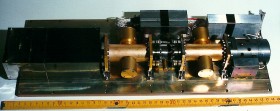
|
HDAC: Hydrogen Deuterium Absorption Cell
|
 |

|
HDAC: Hydrogen Deuterium Absorption Cell
|
 |
 The Hydrogen Deuterium Absorption Cell (HDAC) is part of the
The Hydrogen Deuterium Absorption Cell (HDAC) is part of the
![]() UltraViolet Imaging Spectrograph (UVIS)
experiment onboard the
UltraViolet Imaging Spectrograph (UVIS)
experiment onboard the
![]() Cassini spacecraft,
a remote sensing instrument for atomic D/H measurements on Saturn and Titan.
Cassini spacecraft,
a remote sensing instrument for atomic D/H measurements on Saturn and Titan.
|
|
Science objectives |
|
|
MPS contribution |
|
|
Instrument description |
|
|
Investigators |
|
|
Related links |
|
CASSINI publications by MPS members |
The Cassini project is a ![]() NASA
mission being built at the Jet Propulsion Laboratory (
NASA
mission being built at the Jet Propulsion Laboratory (![]() JPL) in Pasadena, California. The
Cassini spacecraft was launched on October 15, 1997. It will reach
Saturn on July 1, 2004.
JPL) in Pasadena, California. The
Cassini spacecraft was launched on October 15, 1997. It will reach
Saturn on July 1, 2004.
The HDAC will do measurements of resonant scattered solar Lyman-alpha radiation to determine the Hydrogen to Deuterium ratio of Saturn's and Titan's atmospheres. These results will lead to a better understanding of the origin and evolution of the solar system, it's planets and their satellites.
The detector is a ![]() ceramic channel electron multiplier.
It was developed at the MPS by Hans Lauche.
ceramic channel electron multiplier.
It was developed at the MPS by Hans Lauche.
contact: Stefan Werner
 MPS has built a Lyman Alpha photometer for the Cassini mission to
Saturn. The instrument is a Hydrogen Deuterium Absorption Cell (HDAC).
The HDAC represents a cooperative effort between the
Max Planck Institute for Solar System Research in Lindau, Germany, and the
Laboratory for Atmospheric and Space Physics
(
MPS has built a Lyman Alpha photometer for the Cassini mission to
Saturn. The instrument is a Hydrogen Deuterium Absorption Cell (HDAC).
The HDAC represents a cooperative effort between the
Max Planck Institute for Solar System Research in Lindau, Germany, and the
Laboratory for Atmospheric and Space Physics
(![]() LASP)
at the university of
Colorado in Boulder. The HDAC is integrated into CU's Cassini UVIS
instrument package. MPS is responsible for the design and contruction
of the instrument, and LASP is responsible for the instrument electronics.
LASP)
at the university of
Colorado in Boulder. The HDAC is integrated into CU's Cassini UVIS
instrument package. MPS is responsible for the design and contruction
of the instrument, and LASP is responsible for the instrument electronics.
 The HDAC is a photometer designed to measure the D and H Lyman Alpha
lines (at 121.53 nm and 121.57 nm). It is capable of measuring the
shapes of these two lines and the atomic D/H ratio on Titan and
Saturn. The instrument consists of a UV detector equipped with gas
filled Hydrogen and Deuterium cells, an O2 filter, and a
light baffle. The H and D cells contain tungsen filaments. When
power is applied to the filaments they dissociate the H2
and D2 molecules into single atoms, which resonantly absorb
D and H Lyman Alpha. By changing the temperature of these filaments,
a tunable set of filters is created. The O2 cell was
designed to filter out unwanted signals near Lyman Alpha.
The HDAC is a photometer designed to measure the D and H Lyman Alpha
lines (at 121.53 nm and 121.57 nm). It is capable of measuring the
shapes of these two lines and the atomic D/H ratio on Titan and
Saturn. The instrument consists of a UV detector equipped with gas
filled Hydrogen and Deuterium cells, an O2 filter, and a
light baffle. The H and D cells contain tungsen filaments. When
power is applied to the filaments they dissociate the H2
and D2 molecules into single atoms, which resonantly absorb
D and H Lyman Alpha. By changing the temperature of these filaments,
a tunable set of filters is created. The O2 cell was
designed to filter out unwanted signals near Lyman Alpha.
The detector is a ![]() ceramic channel electron
multiplier. It was developed at the MPS by Hans Lauche.
ceramic channel electron
multiplier. It was developed at the MPS by Hans Lauche.
The analysis of the HDAC data is done by scientists at the ![]() Max Planck Institute for Solar System Research (MPS)
in Lindau, and by scientists at the
Max Planck Institute for Solar System Research (MPS)
in Lindau, and by scientists at the
![]() Institute of Space Sensor Technology and Planetary Exploration at the DLR, in Berlin.
Institute of Space Sensor Technology and Planetary Exploration at the DLR, in Berlin.
|
Cassini at Jet Propulsion Laboratory in Pasadena, California |
|
|
Laboratory for Atmospheric and Space Physics at the university of Colorado in Boulder |
|
|
Institute of Space Sensor Technology and Planetary Exploration at the DLR, in Berlin |
| © 2006, Max Planck Institute for Solar System Research, Lindau |
Stefan Werner 19-02-2002 |